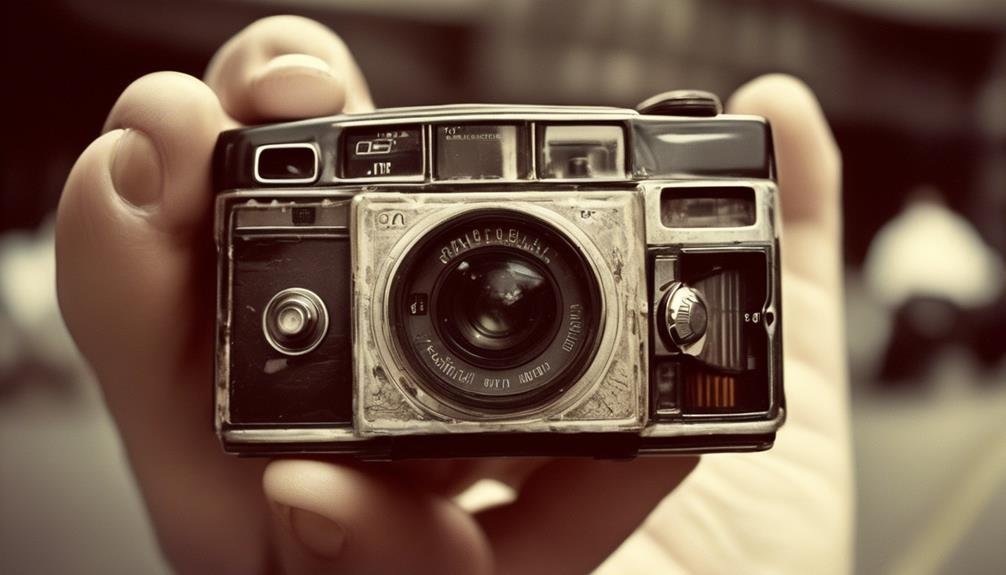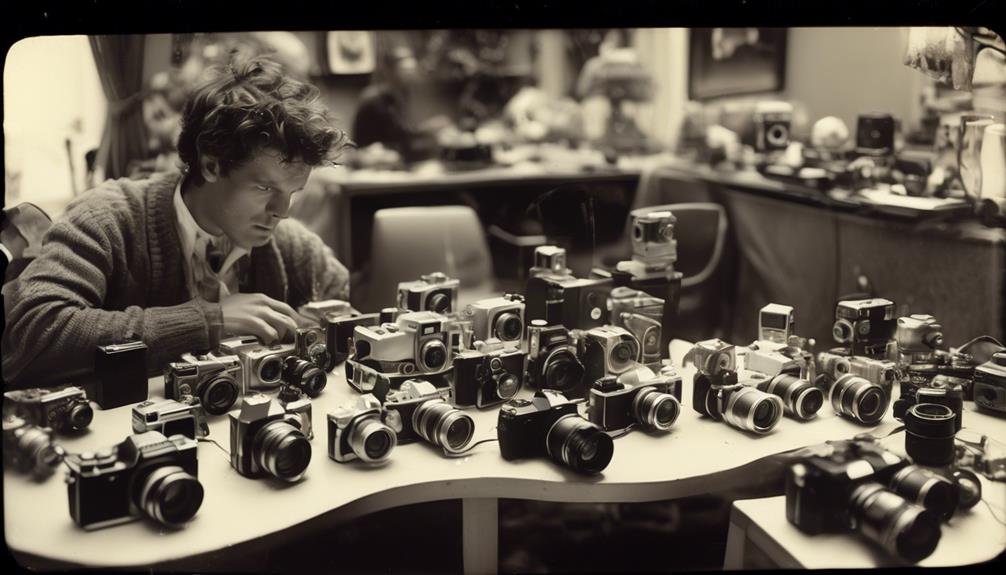
When it comes to choosing a new camera, we often find ourselves torn between the allure of traditional DSLR traits and the modern advancements in mirrorless technology. How do we strike a balance between the two, and what factors should we consider to ensure we get the best of both worlds? With the rapid evolution of camera technology, it can be overwhelming to navigate the array of options available. But fear not, as we have compiled eight essential tips to guide you through the process of selecting a camera that seamlessly blends the classic features of a DSLR with the innovative capabilities of a mirrorless camera.
Consider Sensor Size
When considering sensor size in cameras, it's crucial to understand how it directly impacts image quality and performance. Sensor size plays a vital role in determining the overall image quality a camera can produce. A larger sensor size allows for more light to be captured, resulting in better performance in low-light conditions and a wider dynamic range. This is especially important for photographers who often find themselves shooting in challenging lighting situations.
Another critical aspect to consider when it comes to sensor size is lens compatibility. Different sensor sizes may require specific lenses to achieve the desired results. For instance, a full-frame sensor camera may require lenses designed specifically for that sensor size to ensure optimal image quality. On the other hand, cameras with smaller sensor sizes may have a different set of compatible lenses. Understanding the relationship between sensor size and lens compatibility is essential for photographers looking to invest in new equipment.
Evaluate Autofocus Performance
Understanding the impact of sensor size on image quality and lens compatibility, we can now turn our attention to evaluating the autofocus performance of cameras. When assessing autofocus capabilities, it's crucial to consider both focus accuracy and focus speed to ensure that the camera meets the demands of various shooting scenarios. Here are some key factors to consider:
- Focus Accuracy:
- Assess the camera's ability to consistently achieve sharp focus on the intended subject, especially in challenging lighting conditions or when capturing fast-moving subjects.
- Look for features such as advanced autofocus algorithms, eye-tracking technology, and reliable low-light focusing performance to ensure accurate and consistent focus results.
- Focus Speed:
- Evaluate how quickly the camera can acquire focus on a specific subject, especially when capturing action or sports photography.
- Consider features like phase-detection autofocus, high-speed focusing motors, and customizable focus tracking options to ensure swift and responsive focus performance.
- Overall Autofocus System:
- Consider the overall autofocus system, including the number of focus points, coverage across the frame, and the camera's ability to adapt to different shooting conditions for enhanced accuracy and speed.
Assess Viewfinder Options

When it comes to assessing viewfinder options, we need to consider the choice between optical and electronic viewfinders. The magnification and coverage of the viewfinder are also crucial factors to take into account. Understanding these points will help us make an informed decision when selecting a camera that blends traditional DSLR traits.
Optical Vs. Electronic
While traditional optical viewfinders provide a direct, unadulterated view of the scene through the lens, electronic viewfinders offer a digital representation with additional information overlay. When considering optical vs. electronic viewfinders, it's essential to weigh the following factors:
- Real-Time Information: Electronic viewfinders provide real-time data overlays, such as histograms and focus peaking, aiding in precise manual focus techniques.
- Adaptability: Electronic viewfinders can simulate different exposure settings and display the effects before capturing the image, allowing for quick adjustments and experimentation.
- Compactness: Electronic viewfinders contribute to a more compact camera design, appealing to photographers seeking portability without compromising advanced features.
These aspects highlight the innovative capabilities of electronic viewfinders, enhancing the overall shooting experience and offering valuable tools for creative expression.
Magnification and Coverage
Given the significance of electronic viewfinders in providing real-time data overlays and enhancing the shooting experience, the assessment of viewfinder options should now focus on magnification and coverage to ensure optimal framing and composition. When considering magnification and coverage, it's crucial to assess lens compatibility to understand how different lenses will affect the viewfinder image. A higher magnification factor allows for a closer, more detailed view of the scene, aiding in precise composition. Additionally, coverage is essential in determining how much of the scene the viewfinder displays, especially when using wide-angle lenses or shooting subjects at varying distances. Understanding these factors will help in selecting a camera with a viewfinder that meets your specific shooting needs, whether it be for landscape photography, portrait shots, or versatile everyday use.
Compare Lens Selection
Comparing lens selection is a crucial aspect of choosing cameras that blend traditional DSLR traits, as it directly impacts the versatility and quality of the images you can capture. When evaluating lens options, consider factors such as lens compatibility and brand options, as these will determine the range of lenses available for your camera. Additionally, pay attention to the focal length, which affects the magnification and field of view, and the aperture range, which influences the amount of light that can enter the lens.
- Lens compatibility and brand options
- Assess the compatibility of lenses with the camera body to ensure a wide selection of lenses for various shooting scenarios.
- Explore different brands and their lens offerings to find the best fit for your specific photographic needs.
- Focal length
- Understand how focal length impacts the magnification and coverage of the image.
- Consider prime lenses for fixed focal lengths and zoom lenses for versatile shooting options.
- Aperture range
- Evaluate the aperture range of lenses to determine their low light performance and ability to create depth of field effects.
Careful consideration of these factors will enable you to make informed decisions when selecting lenses for your traditional DSLR-inspired camera.
Examine Battery Life and Ergonomics

Examining battery life and ergonomics in a camera is essential for ensuring a reliable and comfortable shooting experience. When evaluating a camera's battery capacity, it's important to consider the demands of your photography. Higher capacity batteries are crucial for prolonged shooting sessions and ensure that you don't miss out on capturing the perfect shot. Additionally, considering the availability of spare batteries or the option for external power sources can further enhance your shooting flexibility.
Ergonomics play a significant role in the overall shooting experience. A well-designed camera with comfortable grip ensures that you can hold the camera steady for extended periods without discomfort or fatigue. The placement of buttons, dials, and the overall feel of the camera in your hands contribute to the ease of use and operational efficiency. When testing a camera for grip comfort, pay attention to how it feels when held for extended periods and whether it provides easy access to essential controls without compromising stability.
Review Image Quality and Low-Light Performance
When comparing image resolution, it's crucial to consider the megapixels of the cameras being reviewed. This will directly impact the level of detail and sharpness that can be captured in your photos. Additionally, low-light sensor performance is a significant factor to consider, as it determines how well the camera can handle shooting in dimly lit environments. Noise reduction technology is another key aspect to evaluate, as it can greatly affect the overall image quality when shooting in low-light conditions.
Image Resolution Comparison
We can evaluate the image resolution and low-light performance of these cameras to determine their image quality. When comparing image resolution, it's essential to consider pixel density analysis, as it directly impacts the sharpness and detail in photos. Additionally, low-light performance is crucial for capturing high-quality images in challenging lighting conditions, making it imperative to assess noise levels and clarity in darker settings. Here are some key factors to consider:
- Image Resolution Comparison
- Pixel Density Analysis
- Sensor Size and Megapixel Count
- Lens Quality and Compatibility
Low-Light Sensor Performance
After analyzing the image resolution and low-light performance of these cameras, it's crucial to now review their low-light sensor performance to understand their ability to capture high-quality images in challenging lighting conditions. When it comes to low-light photography, the ISO sensitivity and noise performance of a camera are crucial factors. A higher ISO sensitivity allows for better performance in low-light conditions, while noise can significantly impact image quality. Cameras with advanced low-light sensor performance can produce clearer and more detailed images even in dimly lit environments. When assessing a camera's low-light performance, it's essential to consider its ability to maintain image quality at higher ISO settings and its noise reduction capabilities. These factors play a significant role in enabling photographers to capture stunning shots in challenging lighting situations.
Noise Reduction Technology
With advanced noise reduction technology, cameras are able to enhance image quality and low-light performance, allowing for clearer and more detailed shots even in challenging lighting conditions.
- Advanced noise reduction technology: Newer camera models incorporate advanced algorithms to reduce digital noise in images, resulting in cleaner and more accurate representations of scenes, especially in low-light conditions.
- Sensor size comparison: Larger sensors generally have better low-light performance and produce less noise compared to smaller sensors. When choosing a camera, consider the sensor size and its impact on noise reduction and image quality in various lighting conditions.
- Improved low-light performance: Noise reduction technology plays a crucial role in improving a camera's ability to capture high-quality images in low-light environments, ensuring that photographers can achieve exceptional results even in challenging situations.
Explore Video Capabilities
Exploring the video capabilities of modern cameras can provide a richer understanding of their potential for capturing dynamic and high-quality visual content. When considering a camera for its video capabilities, it's essential to assess factors such as video recording quality and video editing features. Today's cameras offer advanced video recording options, making them suitable for professional videography, vlogging, or capturing family moments in stunning detail. To help you understand the range of features available, let's explore a comparison of video capabilities in different camera models.
| Camera Model | Max Video Resolution | Frame Rate Options | Video Editing Features | Image Stabilization |
|---|---|---|---|---|
| Canon EOS R5 | 8K | Up to 120 fps | Advanced | In-body and lens |
| Sony A7S III | 4K | Up to 120 fps | Extensive | 5-axis |
| Panasonic GH5 | 4K | Up to 60 fps | Professional | 5-axis |
These cameras exemplify the diverse video capabilities available, catering to different needs, whether it's shooting cinematic quality footage, capturing fast-paced action, or facilitating seamless video editing.
Research Connectivity and Accessories

As we discover the video capabilities of modern cameras, it becomes evident that researching connectivity and accessories is pivotal to fully harnessing their potential for creating compelling visual content. When delving into the realm of connectivity options, it's essential to consider the seamless integration of wireless technologies such as Bluetooth and Wi-Fi. These features allow for effortless transfer of high-resolution images and videos to other devices for editing and sharing. Additionally, the compatibility of accessories like external microphones, stabilizers, and lighting attachments greatly influences the overall quality of video production. It's crucial to ensure that the chosen camera supports a wide range of accessories, enabling flexibility and adaptability to various shooting conditions. Furthermore, exploring the availability of ports for connecting to external monitors or recorders can significantly enhance the monitoring and recording capabilities of the camera, opening up new creative possibilities. Lastly, investigating the compatibility with remote control systems or smartphone apps can revolutionize the way the camera is operated, offering innovative ways to capture stunning visual content.
Frequently Asked Questions
Can I Use My Old Lenses With a New Camera That Has a Different Sensor Size?
Absolutely, you can adapt old lenses to a new camera with a different sensor size. However, it's important to consider potential changes in focal length and aperture due to the crop factor of the new sensor.
How Does the Camera's Autofocus Performance Compare in Different Lighting Conditions?
In low light, contrast detection autofocus excels, while phase detection shines in outdoor shooting. The camera's autofocus performance varies based on lighting conditions. It's crucial to consider these factors when selecting a camera for diverse shooting environments.
Are There Any Options for Electronic Viewfinders or Only Optical Viewfinders Available for This Camera Model?
Yes, electronic viewfinders are available for this camera model, offering advanced features like real-time exposure simulation. They enhance camera compatibility and are beneficial for assessing lens performance, especially in low light conditions.
Can I Use Third-Party Lenses With This Camera, or Am I Limited to the Manufacturer's Lens Selection?
Yes, third-party lenses can be used with this camera, offering compatibility with a wide range of old and new lenses. However, it's essential to consider sensor size, autofocus performance, and lighting conditions for optimal results.
What Is the Estimated Battery Life When Shooting in Different Conditions, Such as Continuous Burst Mode or Video Recording?
Battery life varies based on shooting conditions, like continuous burst mode or video recording. We've found that in ideal conditions, the battery life is impressive. However, in demanding scenarios, it may require frequent recharging.
